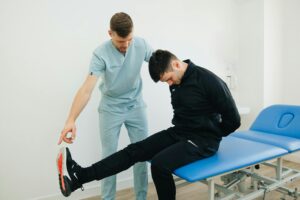Key Pointers:
- Heel pain is one of the most common causes of foot discomfort.
- While plantar fasciitis is the leading cause, other conditions like bursitis, nerve entrapment, and heel spurs can also contribute.
- Early diagnosis and proper treatment can help relieve pain and restore mobility.
Why Does Heel Pain Happen?
Heel pain can develop gradually or suddenly, often due to overuse, injury, or poor foot mechanics. The heel bears much of the body’s weight when walking or standing, which makes it prone to strain and inflammation over time.
In Singapore, it’s especially common among runners, people who stand for long hours, and those who wear unsupportive footwear.
1. Plantar Fasciitis: The Classic Cause
What it is:
Plantar fasciitis occurs when the plantar fascia, the thick band of tissue connecting your heel to your toes, becomes inflamed.
Common signs:
- Sharp pain at the bottom of the heel, especially during the first few steps in the morning
- Discomfort after prolonged standing or exercise
Treatment may include:
- Rest and stretching
- Supportive footwear or orthotics
- Physiotherapy and shockwave therapy
- Corticosteroid or platelet-rich plasma (PRP) injections (if conservative care fails)
2. Heel Bursitis: Inflammation Behind the Heel
What it is:
Bursitis affects the small fluid-filled sac (bursa) that cushions the heel bone. It can occur due to repetitive pressure, tight footwear, or prolonged standing.
Common signs:
- Pain at the back of the heel
- Swelling or redness
- Pain that worsens when walking uphill or climbing stairs
Treatment may include:
- Ice and anti-inflammatory medication
- Footwear modification
- Physical therapy to improve ankle flexibility
3. Nerve Entrapment: When Pain Radiates or Burns
What it is:
Sometimes heel pain is caused not by inflammation, but by nerve compression, especially the tibial nerve or its branches.
Common signs:
- Tingling, burning, or shooting pain
- Numbness around the heel or sole
- Pain that worsens at night
Treatment may include:
- Nerve-gliding exercises
- Physiotherapy
- Occasionally, a nerve release procedure
4. Heel Spurs: Bony Growths Under the Heel
What it is:
A heel spur is a calcium deposit that forms on the heel bone, often due to chronic strain on the plantar fascia. Heel spurs themselves are not always painful, but when combined with inflammation, they can cause significant discomfort.
Treatment may include:
- Stretching and physiotherapy
- Shockwave therapy
- In rare cases, surgical removal if pain persists
5. Other Possible Causes
Less common causes of heel pain include:
- Stress fractures from overuse or osteoporosis
- Arthritis affecting the ankle or heel joints
- Infections or systemic inflammatory conditions
Your orthopaedic specialist may recommend imaging such as X-rays or MRI scans to confirm the diagnosis and rule out other conditions.
When to See a Doctor for Heel Pain
Seek medical attention if you experience:
- Persistent heel pain for more than two weeks
- Swelling, bruising, or redness
- Pain that disrupts walking or sleep
- Numbness or tingling
Early evaluation helps identify the cause and prevent long-term issues such as chronic plantar fasciitis or nerve irritation.
Treatment at a Glance
| Cause | Typical Treatment |
| Plantar Fasciitis | Rest, physiotherapy, orthotics, injections |
| Heel Bursitis | Footwear modification, anti-inflammatory therapy |
| Nerve Entrapment | Physiotherapy, nerve release if needed |
| Heel Spurs | Shockwave therapy, stretching, surgery (rare) |
Frequently Asked Questions (FAQ)
1. Why is my heel pain worse in the morning?
This is a hallmark symptom of plantar fasciitis. When resting, the fascia tightens; stepping again after sleep causes sharp pain as it stretches.
2. Can heel pain go away on its own?
Mild cases may improve with rest and stretching, but persistent heel pain lasting over two weeks should be assessed by an orthopaedic doctor.
3. Are heel spurs the same as plantar fasciitis?
No. Heel spurs are bony growths that may develop due to chronic strain from plantar fasciitis, but the two are distinct conditions.
4. What kind of shoes help with heel pain?
Supportive shoes with good cushioning and arch support help reduce strain on the heel. Avoid worn-out soles or high heels for extended periods.
5. When is surgery considered?
Surgery is only recommended if conservative treatment fails to relieve symptoms after several months. This may involve releasing tight tissues or removing a heel spur.
Book a Consultation
If heel pain is affecting your daily life, book a consultation with our orthopaedic specialist for a detailed assessment and treatment plan tailored to your needs.
📍 Farrer Park Medical Centre, #07-14 Connexion, Singapore 217562
📞 +65 6518 9545 👉 Message us for an appointment













